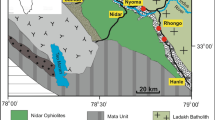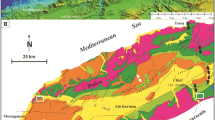Abstract
The present geophysical study deals with the ores and crustal demonstration of southeastern Hazara and its adjoining areas of Azad Jammu and Kashmir, Pakistan, on the basis of terrestrial gravity and magnetic data. Tectonically, the study area lies in the Lesser Himalayas as well as to an extent in the sub-Himalaya, more specifically in the western limb of Hazara Kashmir Syntaxis. In this study, 567 gravity and 508 magnetic stations have been measured with CG-5 gravimeter and proton precession magnetometer, respectively. The collected data have been processed by applying standard corrections and then different types of maps were prepared. The ores in the area have been delineated by the qualitative interpretation of residual Bouguer anomaly and reduction to pole total magnetic intensity maps, whereas regional structures are demarcated by the Bouguer anomaly and regional Bouguer anomaly maps. The positive contour closures on the residual Bouguer anomaly map indicate the iron ore and phosphate, whereas negative contour closures are the effects of low-density material which consists of gypsum and soapstone. The pole-reduced total intensity map also shows the negative and positive contour closures almost in the same localities and confirms the residual Bouguer anomaly map. The geological model computed on the basis of Bouguer anomaly demarcated a series of faults between different rock units in the study area. The Kashmir Boundary Thrust cuts the western limb of Hazara Kashmir Syntaxis near the apex in the north of Muzaffarabad and marks the boundary between Murree Formation and carbonates of Abbottabad Formation. The gravity model also suggests that the thickness of the crust increases towards the northeast.








Similar content being viewed by others
References
Ahmad I, Khan SD, Lapen T, Burke K, Jehan N (2013) Isotopic ages for alkaline igneous rocks, including a 26 Ma ignimbrite, from the Peshawar plain of northern Pakistan and their tectonic implications. J Asian Earth Sci 62:414–424
Ashraf M, Malik MI (1983) Prospects and development of phosphate deposits of Lagarban area Abbottabad, Pakistan. Kashmir. J Geol 1:77–83
Asrarullah (1976) Iron ores in Pakistan. Unpublished Report, Geological Survey of Pakistan, 25 p
Bai Z, Zhang S, Braitenberg C (2013) Crustal density structure from 3D gravity modeling beneath Himalaya and Lhasa blocks, Tibet. J Asian Earth Sci 78:301–317
Baig MS, Lawrence RD (1987) Precambrian to Early Paleozoic orogenesis in the Himalaya. Kashmir J Geol 5:1–22
Blakely RJ (1995) Potential theory in gravity and magnetic applications. Cambridge University Press, Cambridge
Butt AA (1972) Problems of stratigraphic nomenclature in the Hazara District, N.W.F.P., Pakistan. Geol Bull Punjab Univ 9:65–69
Calkins JA, Offield TW, Ali ST (1969) Geology and mineral resources of southern Hazara district, West Pakistan and parts of western Kashmir. Project Report PK-43(17), United States Department of State and Government of Pakistan
Calkins JA, Offield TW, Abdullah SKM, Ali ST (1975) Geology of the southern Himalaya in Hazara Pakistan and adjacent areas. U S Geol Surv Prof Pap 716-C:1–29
Caporali A (1995) Gravity anomalies and the flexure of the lithosphere in the Karakoram, Pakistan. J Geophys Res 100:15075–15085
Caporali A (2000a) The gravity field of the Karakoram Mountain Range and surrounding areas. In: Khan MA, Treloar PJ, Searle MP, Jan MQ (eds) Tectonics of Nanga Parbat syntaxis and the Western Himalaya, vol 170. Geological Society London, Special Publications, pp 7–23
Caporali A (2000b) Buckling of the lithosphere in Western Himalaya, constraints from gravity and topography data. J Geophys Res 105:3103–3113
Chatterjee S, Goswami A, Scotese CR (2013) The longest voyage: tectonic, magmatic, and paleoclimatic evolution of the Indian plate during its northward flight from Gondwana to Asia. Gondwana Res 23(1):238–267
Das D, Mehra G, Rao KGC, Roy AL, Narayana MS (1979) Bouguer, free-air and magnetic anomalies over northwestern Himalaya. Himalayan Geology seminar, Section III, Oil and Natural Gas Resources, Geological Survey of India Miscellaneous Publication 41:141–148
DiPietro JA, Pouge K (2004) Tectonostratigraphic subdivisions of the Himalaya: a view from the west. Tectonics 23:TC5001. https://doi.org/10.1029/2003TC001554
Dobrin MB, Savit CH (1988) Introduction to geophysical prospecting, 4th edn. McGraw-Hill, New York
Duroy Y, Farah A, Lillie RJ (1989) Subsurface densities and lithospheric flexure of the Himalayan foreland in Pakistan. In: Malinconica LL Jr, Lillie RJ (ed) Tectonics of the Western Himalayas. Geological Society of America, Special Paper 232:217–236
Geological Survey of Pakistan (2004a) Geological map of the Nauseri area, district Muzaffarabad, AJK (1:50,000)
Geological Survey of Pakistan (2004b) Geological map of the Ghari Habibullah area, district Mansehra and parts of Muzaffarabad District, AJK (1:50,000)
Geological Survey of Pakistan (2004c) Geological map of the Mahandri area, Mansehra District and parts of Muzaffarabad District, AJK (1:50,000)
Geological Survey of Pakistan (2004d) Geological map of the Dhirkot area, Muzaffarabad and Bagh Districts, AJK and parts of Rawalpindi and Abbottabad Districts, NWFP, Pakistan (1:50,000)
Geological Survey of Pakistan (2008) Geological map of the Balakot quadrangle (earth quake affected area), district Mansehra, NWFP, Pakistan (1:50,000)
Geological Survey of Pakistan (2010) Geological map of the Nathia Gali quadrangle, Abbottabad and Mansehra Districts, Khyber Pakhtunkhwa, and parts of Rawalpindi and Muzaffarabad Districts (1:50,000)
Greco A (1989) Tectonic and metamorphism of the western Himalayan Syntaxis area (Azad Kashmir NE Pakistan). Dissertation, ETH Zurich
Hinze WJ, von Frese RRB, Saad AH (2013) Gravity and magnetic exploration—principles, practices, and applications. Cambridge University Press, Cambridge 420 p
Kazmi AH (1977) Application of ERTS-I imagery to recent tectonic studies in Pakistan. Project Report 10, United States Geological Survey
Kono M (1974) Gravity anomalies an east Nepal and their implications to the crustal structure of the Himalayas. Geophys J R Astron Soc 39:283–300
Latif MA (1970) Explanatory notes on the geology of south eastern Hazara, to accompany the revised geological map. Jahrbuch Derngeol Sogischen Bundesanstalt, Wien Sonderband 15:5–19
Latif MA (1973) Partial extension of the evaporate facies of the Salt Range to Hazara Shale, Pakistan. Nature (138):124–125
Le Fort P (1975) Himalayas: the collided range. Present knowledge of the continental arc. Am J Sci 275(1):1–44
Leather M (1987) Balanced structural cross-section of the western Salt Range and Potwar Plateau, deformation near the strike-slip terminus of an overthrust sheet. M.S. Thesis, Oregon State University, Corvallis, Oregon, 1–200 p
Lyon-Caen H, Molnar P (1985) Gravity anomalies, flexure of the Indian plate, and structure, support and evolution of the Himalaya and Ganga Basin. Tectonics 4:513–538
Malinconico LL (1986) The structure of the Kohistan-arc terrane in northern Pakistan as inferred from gravity data. Tectonophysics 124(3–4):297–307
Marussi A, Ebblin (1976) The tectonic scheme of Central Asia (compiled), Bouguer anomaly map (1975). Accademia Nazionale dei Lincei 21:131–137
Minster JB, Jordan TH (1978) Present-day plate motions. J Geophys Res Solid Earth 83(B11):5331–5354
Mishra DC, Rajasekhar RP (2006) Crustal structure at the epicentral zone of 2005 Kashmir (Muzzafarahad) earthquake and seismotectonic significance of lithospheric flexure. Curr Sci 90:1406–1412
Pogue KR, Hylland MD, Yeats RS, Khattak WU, Hussain A (1999) Stratigraphic and structural framework of Himalayan foothills, northern Pakistan. In: Macfarlane A, Sorkhabi RB, Quade J (ed) Himalaya and Tibet: mountain roots to mountain tops. Geological Society of America Special Paper 328:257–274
Rustam MK, Ali M (1994) Preliminary gravity model of Western Himalayas in northern Pakistan. Kashmir J Geol 11–12:59–65
Rustam MK, Ali M (1997) Tectonics of the Hazara and adjoining areas, based on gravity data, northwest Himalaya, Pakistan. Geol Bull Univ Peshawar 30:273–283
Rustam MK, Khan MS (2003) Study of shallow geological structures in the core of Hazara Kashmir Syntaxis based on residual gravity data in Azad Jammu & Kashmir Pakistan. Geol Bull Punjab Univ 38:35–42
Rustam MK, Hameed F, Mughal MS, Basharat M, Mustafa S (2016) Tectonic study of the sub-Himalayas based on geophysical data in Azad Jammu and Kashmir and northern Pakistan. J Earth Sci 27:981–988
Searle MP, Khan MA (1996) Geological map of North Pakistan and adjacent areas of Northern Ladakh and Western Tibet (1: 650,000)
Seeber L, Armbruster J (1979) Seismicity of the Hazara Arc in northern Pakistan: decollement versus basement faulting. In: Farah A, DeJong KA (eds) Geodynamics of Pakistan. Geological survey of Pakistan, Quetta, pp 131–142
Shah SMI (1977) Stratigraphy of Pakistan. Memoir Geological Survey of Pakistan 12:1–137
Shah MT, Moon CJ (2004) Mineralogy, geochemistry and genesis of the ferromanganese ores from Hazara area NW Himalayas northern Pakistan. J Asian Earth Sci 23:1–15
Sharma PV (1986) Geophysical methods in geology, 2nd edn. Elsevier, Amsterdam 91 p
Talwani M, Worzed JL, Landisman M (1959) Rapid gravity computation of two dimensional bodies with application to the Malinconico submarine fracture zones. J Geophys Res 64:49–59
Tiwari VM, Rajasekhar RP, Mishra DC (2009) Gravity anomaly, lithospheric structure and seismicity of Western Himalayan Syntaxis. J Seismol 13:363–370
Verma RK, Prasad KAVL (1987) Analysis of gravity fields in the northwestern Himalayas and Kohistan region using deep seismic sounding data. Geophys J Int 91:869–889
Wadia DN (1928) The geology of Poonch State (Kashmir) and adjacent portions of the Punjab. Memoirs of the Geological Survey of India 51:185–370
Wadia DN (1930) Hazara Kashmir syntaxis. Records of the Geological Survey of India 63:129–138
Wadia DN (1931) The syntaxis of northwest Himalaya: its rocks, tectonics and orogeny. Records of the Geological Survey of India 65:189–220
Zahid M, Ahmad S, Rehman G, Ali F (2009) Structural geometry of a part of the southeastern Hazara fold-thrust belt Khyber Pakhtunkhwa Pakistan. Pak J Hydrocarbon Res 19:19–28
Acknowledgements
The authors would like to thank Higher Education Commission (HEC), Pakistan for providing the financial support and the Director, Institute of Geology, University of Azad Jammu and Kashmir, Muzaffarabad, for his kind cooperation. We sincerely thank the anonymous reviewers for their insightful suggestions that improved the manuscript.
Funding
The present study is a part of the project “Tectonic and Mineral Study of Hazara and its Adjoining Areas of Azad Jammu and Kashmir and Northern Pakistan Based on Gravity and Magnetic Data” funded by the Higher Education Commission (HEC), Pakistan, under National Research Program for Universities (NRPU).
Author information
Authors and Affiliations
Corresponding author
Rights and permissions
About this article
Cite this article
Khan, M.R., Bilali, S.S., Hameed, F. et al. Application of gravity and magnetic methods for the crustal study and delineating associated ores in the western limb of Hazara Kashmir Syntaxis, Northwest Himalayas, Pakistan. Arab J Geosci 11, 131 (2018). https://doi.org/10.1007/s12517-018-3483-9
Received:
Accepted:
Published:
DOI: https://doi.org/10.1007/s12517-018-3483-9




